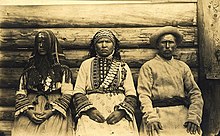 | |
| Regions with significant populations | |
|---|---|
| Udmurtia (Russia) | |
| 2,036 (2021) | |
| Languages | |
| Udmurt (Besermyan dialect) | |
| Religion | |
| Majority: Sunni Islam Minority: Russian Orthodoxy | |
| Related ethnic groups | |
| Udmurts, Chepetsk Tatars | |
The Besermyan, Biserman, Besermans or Besermens (Russian: бесермяне, besermyane singular: besermyanin, Udmurt: бесерманъёс, Tatar: бисермәннәр, romanized: bisermännär) are a numerically small Permian people in Russia.
The Russian Empire Census of 1897 listed 10,800 Besermans. There were 10,000 Besermans in 1926, but the Russian Census of 2002 found only 3,122 of them.
The Besermyan live in the districts of Yukamenskoye, Glazov, Balezino, and Yar in the northwest of Udmurtia. There are ten villages of pure Besermyan ethnicity in Russia, and 41 villages with a partial Besermyan population.

History
The Besermyan are of Turkic origin, and are probably the result of a group of Tatars who were assimilated by the Udmurts. In the 13th century during his travel to Mongolia, papal envoy Plano Carpini claimed that the Besermyan were subjects of the Mongols. Russian chronicles sometimes made mention of the Besermyan but it's unclear whether the term was meant to denote the modern group as it was a common derivation of the term "musulman" (Muslim). It is likely that the term had broader usage before it became an ethnonym.
Culture
The language of the Besermyan is a dialect of the Udmurt language with Tatar influences. Although they speak a dialect of Udmurt, the Besermyan consider themselves a distinct people.
Some Besermyan traditions differ from other Udmurtian customs due to the Islamic influence during the Volga Bulgaria and Khanate of Kazan periods.
The Besermyan used to historically practice their own indigenous religion. According to scholar Shirin Akiner, most current Besermyan practice Sunni Islam. Some Besermyan also practice Christianity. The Russians began converting the Besermyan to Christianity around the middle of the 18th century.
Genetics
In a mtDNA research which was done on Besermyans there were 41 tested persons from the village of Yozhovo in Yukamenskovo raion of Udmurtia. The proportion of Eastern Eurasian haplogroups, primarily of haplogroup C, turned out to be significantly higher than that of the Udmurts. According to this indicator, the Besermyans genetically stand out against the background of the Volga-Ural region and are closer to the Turkic-speaking peoples of Southern Siberia.
A study was conducted of the Y-chromosome haplogroups of 53 Besermyans from the villages of Yukamenskoye and Yozhevo, as well as the village of Shamardan, Yukamensky district of Udmurtia. It turned out that more than half of the samples belong to haplogroup N, which may indicate the predominance of the Finno-Ugric component in the formation of the Besermyans along their male line.
Genetically, Besermayns seem to be descended mostly from Udmurts on their paternally and from the sub-group of Kazan Tatars - Chepetsk Tatars, maternally.
The data from lexicostatistics also did not reveal a noticeable Bulgar (Old Chuvash) substrate in the Besermyan dialect. Only Tatar adstrate, associated with the Chepetsk Tatars, can be traced.
According to a 2019 study, the Besermyan's autosomal genetic admixture can be modeled as mostly Srubnaya-like and about 25 percent Nganasan-like.
References
- Национальный состав населения Российской Федерации согласно переписи населения 2021 года [National composition of the population of the Russian Federation according to the 2021 population census] (in Russian). RU: GKS.
- ^ Bondarenko, Dmitri; Kazankov, Alexander; Khaltourina, Daria; Korotayev, Andrey (2005). "Ethnographic Atlas XXXI: Peoples of Easternmost Europe". Ethnology. 44 (3): 262. doi:10.2307/3774059. ISSN 0014-1828. JSTOR 3774059.
- demoskop.ru: Alphabetical list of peoples of the Russian Empire Archived 2012-02-05 at the Wayback Machine
- ^ Akiner, Shirin (1986). Islamic Peoples Of The Soviet Union. Routledge. p. 103. ISBN 978-1-136-14266-6.
- Sinor, Denis (1988). Handbuch Der Orientalistik. BRILL. p. 765. ISBN 978-90-04-07741-6.
- Olson, James Stuart; Pappas, Lee Brigance; Pappas, Nicholas Charles (1994). An Ethnohistorical Dictionary of the Russian and Soviet Empires. Greenwood Publishing Group. pp. 104–105. ISBN 978-0-313-27497-8.
- Wixman, Ronald (2017-07-28). Peoples of the USSR: An Ethnographic Handbook. Routledge. p. 27. ISBN 978-1-315-47540-0.
- Dalby, Andrew (2015). Dictionary of Languages: The definitive reference to more than 400 languages. Bloomsbury Publishing. p. 324. ISBN 978-1-4081-0214-5.
- Olson, James Stuart; Pappas, Lee Brigance; Pappas, Nicholas Charles (1994). An Ethnohistorical Dictionary of the Russian and Soviet Empires. Greenwood Publishing Group. pp. 104–105. ISBN 978-0-313-27497-8.
- ^ Bremmer, Ian; Taras, Ray (1996). New States, New Politics: Building the Post-Soviet Nations. Cambridge University Press. p. 180. ISBN 978-0-521-57101-2.
- Akiner, Shirin (1986). Islamic Peoples Of The Soviet Union. Routledge. p. 103. ISBN 978-1-136-14266-6.
- Грошева А. Н., Шнейдер Ю. В., Морозова И. Ю., Жукова О. В., Рычков С. Ю. Генетическое разнообразие бесермян по данным о полиморфизме митохондриальной ДНК // Генетика. 2013. № 11. С. 1337—1344.
- Трофимова Н. В., Литвинов С. С., Хусаинова Р. И. и др. Генетическая характеристика популяций Волго-Уральского региона по данным об изменчивости Y-хромосомы // Генетика. 2015. Т. 51. № 1. С. 120—127.
- Jeong, Choongwon; Balanovsky, Oleg; Lukianova, Elena; Kahbatkyzy, Nurzhibek; Flegontov, Pavel; Zaporozhchenko, Valery; Immel, Alexander; Wang, Chuan-Chao; Ixan, Olzhas; Khussainova, Elmira; Bekmanov, Bakhytzhan; Zaibert, Victor; Lavryashina, Maria; Pocheshkhova, Elvira; Yusupov, Yuldash (2019-04-29). "The genetic history of admixture across inner Eurasia". Nature Ecology & Evolution. 3 (6): 966–976. Bibcode:2019NatEE...3..966J. doi:10.1038/s41559-019-0878-2. ISSN 2397-334X. PMC 6542712. PMID 31036896.
- kominarod.ru: Бесермяне (in Russian)
- "Bisermän". Tatar Encyclopaedia (in Tatar). Kazan: The Republic of Tatarstan Academy of Sciences. Institution of the Tatar Encyclopaedia. 2002.
| Peoples speaking Uralic languages | |
|---|---|
| Baltic Finns | |
| Sámi | |
| Volga Finns | |
| Permians | |
| Ob-Ugrians | |
| Hungarians | |
| Samoyeds | |